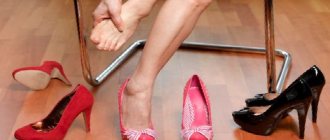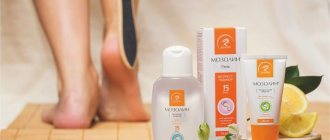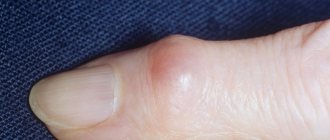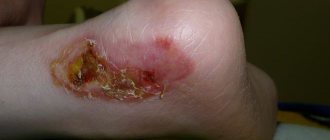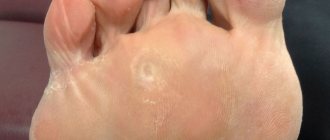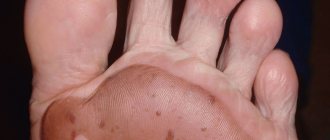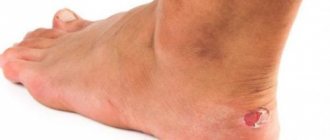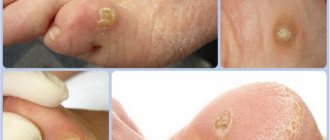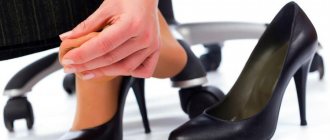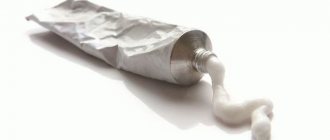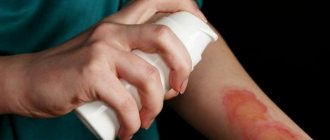Calluses are a common problem that causes physical discomfort and requires immediate treatment. The cause is a mechanical effect that damages a certain area of the skin. The appearance of calluses on the feet is often caused by ill-fitting shoes. Neglected wounds from corns are much more difficult to treat than treating a callus on the foot immediately after it appears. The speed and effectiveness of healing depends on the timeliness of assistance provided.
What is a callus
Callus is a local thickening and roughening of the skin. The formation has a white, yellowish or grayish tint. The seal on the leg interferes with walking, causes pain, and causes inconvenience. Older people who are obese often face this problem.
Causes
Mostly, thickening of the skin on the legs occurs due to wearing uncomfortable shoes. High-heeled shoes and tight boots increase the load on the forefoot. As a result, the gait changes, and constant friction causes local thickening of the skin.
Risk factors for lumps include:
- diabetes;
- flat feet;
- avitaminosis;
- heel spurs;
- incorrect posture;
- hammertoes;
- leg injuries.
Kinds
- A wet (water) callus is a fluid-filled blister. The contents are transparent, less often yellowish or reddish. After opening, the blister looks like a regular wound.
- Dry (hard) - a keratinized area of skin with a grayish tint. When walking or pressing, such seals cause burning and pain. Dry calluses often occur against the background of old wet blisters.
- A corn is a hard formation on the feet without clear boundaries. The lump hurts and makes it difficult to walk.
- Rod (growing) - a rounded thickening with a rod in the middle. It is difficult to remove internal calluses on the foot; you cannot do this without the help of a doctor. The thickenings cause severe pain when walking.
Anti-callus patches
To speed up healing, you can use a special anti-callus patch:
- Compide - suitable for wet and dry corns, relieves pain, promotes rapid recovery;
- Leuko - disinfects, accelerates healing, prevents the penetration of bacteria;
- Salipod - softens keratinized tissue, suppresses inflammation, and has regenerating properties.
If the blister interferes with walking, and the patch does not reduce pain, then you should not wait for natural healing. In this case, it is necessary for the dropsy to burst. To do this, you need to carry out the following manipulation:
- disinfect the corns and nearby skin;
- make several punctures with a thin needle;
- let the liquid drain out, squeeze out the remaining residue with a dry cloth;
- Do not tear off the skin, but press it tightly to the wound and lubricate it with healing ointment (Levomekol, Bepanten).
Dry calluses can be removed with a pumice stone, after softening them in water with ammonia and baking soda.
Remedies for calluses
At home, pumice stone and apple cider vinegar will help remove the painful lump. It is not so easy to remove hard calluses with a stick. To do this, you will need a course of foot baths. You can speed up the process if you add oils and products with urea.
Baths
To eliminate a small chafing, you will need 2-3 procedures, and to remove an old callus – about 10 sessions. Continue until the skin is soft.
Execution order:
- Steam your feet in a soap and soda solution for 20–30 minutes. Water temperature – 40 or a little more.
- When the stratum corneum softens, treat the seal with pumice.
- Lubricate your feet with moisturizer.
Oils
Castor oil is suitable for treating skin inflammation. It softens, accelerates healing, and helps remove rough calluses on the fingers and feet. To get the effect, rub the oil into clean skin of your feet for a week. Repeat the course after a three-day break.
Tea tree oil is no less useful. A natural antiseptic that copes well with any infection.
Add 4-5 drops to warm water and take a foot bath for 15 minutes. No longer worth it - tea tree oil is highly concentrated and sometimes corrodes the skin.
Apple vinegar
This product softens the stratum corneum due to a large amount of acid. To reduce a callus:
- Add a glass of vinegar to a liter of warm water and soak your feet in the solution for 20–30 minutes.
- When the thickening softens, treat the surface with pumice or a special file.
- Apply moisturizer and wear cotton socks.
Pumice
This porous material does a good job of removing rough skin and corns. During foot treatment, blood flow improves and healing accelerates.
Massage with pumice stone on steamed skin.
Movements should be intense, but not painful. Carry out the procedure 3-4 times a week. More often it is impossible - the development of an inflammatory process is possible.
Soda
The product acts as a skin softener and peeling. Add baking soda to baths or use as a scrub. To enhance the effect, mix the powder with shower gel. Rub the resulting paste into rough skin. If the seal is too hard, use additional pumice. The effect is noticeable within two weeks.
When to see a doctor
When calluses cause suffering, especially if signs of inflammation appear , contacting a doctor is the best solution.
A specialist, surgeon or traumatologist, will examine the foot, analyze the degree of danger of the formation, possible consequences, assess the presence of provoking factors that caused the appearance of the callus, and provide the necessary assistance.
At the same time, he will not only do everything to cure the callus, but also give recommendations on how to prevent its occurrence.
Note! Bone and joint calluses can only be removed surgically, so do not delay a visit to the doctor in case of such problems.
How to get rid of calluses
Treatment tactics depend on the type and cause of chafing. Perhaps it's due to uncomfortable shoes or poor posture. Then you will need to consult an orthopedist. The doctor will help you choose shoes and insoles. If the cause is excess weight or vitamin deficiency, the problem can be eliminated with diet, physical activity, and medications.
Before removing thickening of the skin, you need to take into account its type. With a wet callus, it is important not to introduce an infection into the wound. Treatment for dry skin should begin as early as possible. For this purpose, keratolytic ointments, creams and plasters are used. At the same time, folk remedies are used. Core calluses are often removed mechanically.
- Duodenogastric reflux
- Colposcopy of the cervix, what is it?
- How to write a resume for a job - sample
From soft
Wet skin compaction can be removed at home. The bladder is not punctured, it is treated with an antiseptic (iodine or brilliant green), then sealed with a band-aid. After a few days, the blister bursts, and the wound soon heals.
If the soft formation greatly interferes, the bubble is opened with a sterile needle. The puncture is made at the base, the liquid is not squeezed out, and the wound is treated with an antiseptic.
If the blister accidentally bursts on its own, the area is washed with peroxide and a bandage with antibacterial ointment is applied.
Among folk remedies, aloe or Kalanchoe juice is used. They lubricate the blister three times a day until it bursts.
From dry
To reduce calluses, pumice is often used. The procedure is carried out on steamed legs. Before going to bed, apply a bandage with Salicylic ointment, which contains acid. A keratolytic patch gives good results if left on for 2-3 days. This product dissolves the seal without damaging healthy tissue. It may contain urea, alkali, salicylic acid, which help remove dry thickening and keratinized areas.
From old
To eliminate such seals, use keratolytic agents or Vishnevsky ointment. She stretches the rod well. The procedure includes steaming the feet in a bath and applying an ointment or patch. You can remove old formations in 10 sessions.
To speed up recovery, apply garlic and onion compresses. Grind equal parts of the components, apply the resulting pulp to the sore spot overnight. The rod comes out after 8–10 procedures.
General principles of treatment
To get rid of callus formation, you need to eliminate the provoking factor. Then anoint the area of damaged skin with any antiseptic (hydrogen peroxide, Chlorhexidine) and cover with a band-aid.
It has been noticed that if the callus is opened and its contents are released, it can heal faster. However, this increases the likelihood of infection. Therefore, it is better to perform the procedure in a medical facility in compliance with the following rules:
- the puncture site must be washed;
- only a disposable needle is used;
- Do not injure the soft tissue inside.
If the callus suddenly bursts, then to prevent the wound from becoming inflamed, you need to grind the Streptocide tablet and apply the resulting powder to the affected area. You can slow down the filling of the formation with liquid and reduce pain by applying ice to the damaged area .
It is not difficult to determine the onset of the inflammatory process. The callus swells, turns red, and purulent discharge appears. In this situation, the problem must be treated by a specialist.
As a rule, the formed formation does not cause anxiety or discomfort in a calm state. Gradually it goes away on its own. In order not to rip off the callus, you need to eliminate or minimize friction on the damaged area. To do this, you need to make your own or purchase special protective pads or patches at the pharmacy.
Professional callus removal
For old dry rubs, professional help is required. A podiatrist is involved in the removal and treatment of calluses. He has in his arsenal tools that quickly and painlessly get rid of corns and core formations. To remove old seals, hardware techniques are used. Sometimes they resort to surgery.
Professional methods of dealing with calluses:
- Laser removal . The procedure eliminates dry formations of any size and structure. Removal of a callus on a toe or other area is carried out using erbium laser beams, which evaporates the keratinized layer. The carbon dioxide installation removes compaction layer by layer and renews skin cells. The rays do not affect healthy areas and do not cause pain. The methods exclude blood infection and do not require recovery.
- Cryotherapy – freezing with liquid nitrogen. The thickening disappears under the influence of low temperature. The procedure is painful and requires rehabilitation.
- Hardware pedicure - drilling out a callus with a cutter using a special device. The doctor removes the stratum corneum in 10–15 minutes. The resulting hole is treated with disinfectant solutions. The method is not suitable for removing rod thickenings.
What not to do
Horny growths cannot be cut off with a sharp blade, knife or scissors.
Such a procedure can cause infection and the formation of an inflammatory process.
You cannot remove a water blister yourself, this will only aggravate the problem, since such a blister is a kind of protection of the subcutaneous layer at the site of friction; removing it will inevitably cause painful irritation of the exposed layer.
If you have painful burst water calluses, you should not lubricate them with brilliant green or iodine , since these products can cause burns on delicate skin that is devoid of the top layer; in addition, both brilliant green and iodine dry out the skin, and this can cause the formation of cracks, which will certainly cause even more painful Feel.
Elimination of sensations without drugs or medications
First of all, it is worth understanding what exactly caused the callus to appear, in what place and at what moment. If these are uncomfortable shoes, then you can wear another one; if you need to wear this particular one, then you can change the insole, remove it, or put a new one on top of the old one, to change the areas of influence of the shoe on the foot.
You can also simply use a band-aid, and if the formations look like dropsy, then you can use cotton wool and a bandage or gauze. It is like bandaging the leg in the area of the formation, in order to minimize the impact on the problem area, we cover it with cotton wool, it looks like a pillow. You can also vary the socks, tights, and stockings you wear. Due to different materials, different densities and different textures, they will have different effects on calluses. People with delicate skin should pay special attention to shoes.
Causes of pain
A large callus will always hurt if the irritating factor, which provokes a mechanical effect on the modified tissues, is not eliminated. Sometimes it happens that a person took off uncomfortable shoes and limited the pressure on the sore foot, but the discomfort remained. This indicates the appearance of an inflammatory process. It is most often caused by pathogenic bacteria that have penetrated through damaged skin into the tissues.
In case of infection, redness, local increase in body temperature and swelling of the leg are observed.
Dry calluses can hurt even without a secondary infection. The keratinized tissue that has penetrated deep into the foot compresses the nerve endings. This causes a person to suffer and experience significant discomfort.
Folk recipes
Before consulting a doctor, you can use traditional medicine recipes; with their help, you can effectively eliminate pain and inflammation. They require simple ingredients that are found in every home. But if traditional methods do not solve the problem, and the callus increases in size, then be sure to consult a specialist.
- Salt baths relieve pain and swelling. To prepare, you will need to dissolve 1-2 tbsp in 1 liter of hot water. l. sea or table salt. Immerse the legs in the container for at least 20 minutes, then treat the rough skin with pumice. After the procedure, you can apply an emollient cream.
- Chamomile baths eliminate discomfort and soften the skin. Pour hot water over chamomile flowers and let steep for an hour. Then the broth is heated to a tolerably hot temperature, and the sore leg is dipped into it. Exposure time is at least 15 minutes.
- Lemon pulp and zest have a keratolytic (softening) effect. After a steam bath, tie a mixture of lemon zest and pulp to the problem area of the dermis and leave it overnight. This recipe is convenient to use if you have a callus on your heel or little toe.
Lemon for calluses and corns
- Mix finely grated raw potatoes, onions and aloe and apply this mixture to the sore callus, wrap the top with film and a bandage. The compress must be left overnight, and the next morning removed and carefully remove the growth with a pumice stone.
- A mixture of aspirin relieves inflammation and pain, softens rough skin. To prepare such a paste, you will need to take 7 tablets of acetylsalicylic acid and 3 teaspoons of lemon juice and water. Mix everything thoroughly until a homogeneous consistency is obtained and apply to the affected area of the epidemic, wrap in cellophane and wrap in a towel. The product is used for no more than 15 minutes, then the leg is thoroughly washed with water and treated with pumice.
- Mix castor oil and Vaseline in equal proportions, dip a cloth and apply it to the damaged area. Then wrap your foot in cellophane and put another sock on top to keep warm. After 3 hours, rinse the foot and remove the growth with pumice.
Folk recipes
